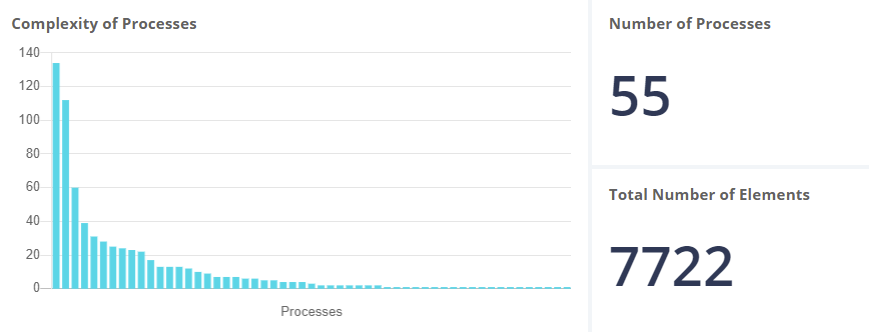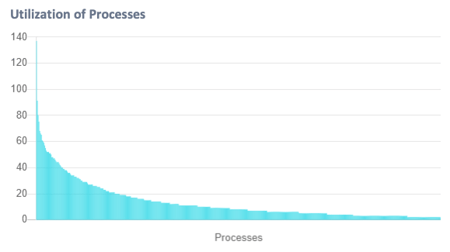5 Process Metrics You Need for Better Business Process Analysis
Business process analysis (BPA) is the gateway to greater efficiency, reduced costs, and real transformation.
However, the rewards BPA promises can only be reaped if you have the proper process metrics driving the insight needed for effective process analysis and improvement.
While these five process metrics can sometimes be overlooked in an organization’s process excellence initiatives, we believe that they are crucial to understanding and improving how work is done in your company today.
1. Complexity of Business Processes
One of the most important pieces of business process analysis is understanding the complexity of the processes that run your organization. Before you can drive downstream outputs like automation or retraining, you need to understand what you have and how your company works today.
A BPA solution that provides a consolidated understanding of the level of complexity for individual and aggregated business processes, reveals where optimization opportunities lie, and how to implement them—for example, illuminating whether reengineering or refactoring a business process would be a profitable decision.

When you understand the complexity you’re dealing with and have optimized that business process, you can then effectively decide what downstream output to drive – like outsourcing or automation – that will deliver the greatest ROI.
2. Processes by Business Unit
Process excellence starts with business process analysis, but a challenge that stumps many stakeholders is: where do you start business process analysis?
This is why seeing which business unit, department, or line of business owns and runs the most processes in your organization is so valuable—it gives you a good indication of where to start your business process analysis initiatives.

Applying a lens of driving transformation and ROI by removing waste, redundancy, and implementing downstream outputs, the business unit with the most processes is often the best candidate to have its processes analyzed.
3. Application Interactions in Your Business Processes
Business processes are now more complex because enterprise architectures have become more complex. Processes now interact with a myriad of different systems and applications. For enterprises operating in highly regulated industries, all the regulations and compliance mandates to contend with are intertwined with this increasing complexity.
Understanding how many and which processes interact with different applications is crucial for effective business process analysis. One of the most prominent pain points organizations experience with their business processes is change management—when you don’t do it right, it costs you a lot of money.

Regulations change all the time. So do applications. The visibility on how this impacts your business is paramount.
Both compliance and change management are highly dependent on having visibility on which processes depend on applications and where those dependencies lie precisely within the process.
Visualizing where your vulnerabilities are and which processes interact with different applications is hugely beneficial for effective change management and efficiency.
4. Utilization of Processes
Like any other strategic enterprise initiative, business process analysis relies on prioritization to drive the greatest business impacts. The insight and visibility on which processes are being run the most is a good indication of which processes can deliver the most ROI if they were to be analyzed and optimized.
 From there, you could also consider the optimal downstream output to boost efficiency and returns. Imagine quickly identifying a process run twice a day, by 10 of your full-time employees that takes them 30 minutes to run on each execution. How much money could you save if you were to optimize that process and reduce the run-time to 20 minutes? How much if you could automate it and reduce it to 2 minutes while getting those same employees to work on more critical, higher-value tasks?
From there, you could also consider the optimal downstream output to boost efficiency and returns. Imagine quickly identifying a process run twice a day, by 10 of your full-time employees that takes them 30 minutes to run on each execution. How much money could you save if you were to optimize that process and reduce the run-time to 20 minutes? How much if you could automate it and reduce it to 2 minutes while getting those same employees to work on more critical, higher-value tasks?
5. Transactions in Processes
Similar to the amount of application interactions in your business processes, the number of transactions in your processes is another overlooked metric that needs attention for effective business process analysis.
The number of transactions in a process – on a whole or by individual process – indicates the degree of complexity of processes and where there’s a possibility for costly errors to be committed.

Reducing the possibility of errors via process analysis and optimization before deciding how to transform the process with better outputs is another step toward increased efficiency and reduced costs by understanding and then transforming how you do work.
At Blueprint, we understand the insight and information enterprises need to transform and improve how their organizations run. That’s why we developed rich dashboards and analytics that give you all the process metrics you need to reduce costs and increase efficiency. Check out Blueprint’s Enterprise Dashboards & Analytics and discover the insight and power you could have at your fingertips.
Share this
Recent Stories

An Essential Guide to Business Process Management (BPM)

What is Process Debt and How to Reduce It



